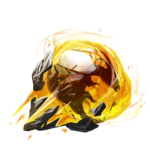
MOONHORN
Conservation Status: (Caligo) Least Concern | (Dolos) Extinct | (Nevermore) Endangered

Moonhorn | Lunar Bison
Bovidae Family
The Moonhorns are known for their mighty crescent shaped horns capable of piercing even the toughest armors when combined with their strength. They often migrate at the start of each season in massive herds until reaching safe havens previously marked by other roaming bisons.
There are five known birthing grounds like the Dakata Valley or Butterfly Fields where Moonhorns gather to breed or fatten up.
A key feature to spotting a Lunar Bison is by the soft iridescent black color of their horns and their size, reaching 8.5-8 feet tall and 15-17 feet long. Estimated weight ranges between 3,500-4,500 lbs.
A Relative to the American Bison:
Considered to be a living ancestor to the surviving bison populations in Dolos, the Moonhorns are among one of the oldest species of bison still thriving in Caligo. They are said to have survived harsh climate changes by means of mass migrations.

The Moonhorns evolved from a prehistoric species of Bovinae. Their large snouts can smell an odor 20 miles away, regardless of weather conditions. The Moonhorn's large appetite is geared to fattening their furry hump loaded with nutrients which serve as an energy reserve when food is scarce. The Andvari were the first sprites to discover this unique bison's favorite food, the Yumberry, and used it as a tool to domesticate them. Today the domestic variant of the Lunar Bison known as the Duwava serve the Andvari as either a powerful steed during times of war, or as a plodding workbeast for farmers and merchants.
Between seasons, the Moonhorns avoid serious predators and environmental threats by sticking together in large social groups. Hungry carnivores tend to travel far distances just to pick off any Moonhorn left behind due to sickness, fatigue, or death. Eukarians are known to protect the Moonhorns traveling within their territories. When a herd leaves the safe territory, Hyperions and humans alike often hunt them as food to sell in their markets. It is a favorite meat among the humans of Moros and many sprites within the gilded dunes of Hyperia.
Recent studies show evidence that Moonhorns are severely nearsighted, yet their hearing and scent glands are excellent. The extreme sense of smell allows them to detect specific scents left behind by other Moonhorns far away. The odors often contain valuable chemical information regarding the type of habitat, dangers, and weather conditions of the area. These scents either guides the herd or turns them away during their travels.

Beast Rank
The Moonhorns can run as fast as 40 mph with a strength that can move twice their weight.
Their horns have been confirmed to rival the Adhark in toughness.
They have not been examined for bites, but they carry a mean stomp!

The Moonhorns were inspired by the Ancient Bison, an ancestor to the American Bison. I wanted to imagine how these large and majestic creatures may have evolved in Caligo, where environmental conditions resemble a greener, foggier, and more diverse Earth. A planet where a larger percentage of creatures survived the mass extinction events. I give thanks to Karlee Ludvik for exploring this beast with me and painting it to life.
H.S. Crow has literary works appearing in all mediums of entertainment with a focus on fantasy, science fiction, and horror. He is an author traversing the breathtaking Caligo, a vast universe containing our dreams and nightmares. Notable books include Lunora and the Monster King, Stars of Glass, & the upcoming Drums of Fog.





